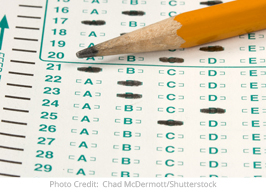2018 Reflections: This Year in SAT/ACT Events

Year-end reflection pieces can be a real drag, especially when they lack a purpose beyond summarizing what happened during the previous twelve months. So, in reconsidering the changes to the SAT and ACT landscape in 2018, let’s consider not only the events, but also their consequences.
SAT
2018 represented the second full calendar year of existence for the SAT’s latest incarnation. Introduced in March 2016, the newest SAT is no longer news…at least not in the way it was almost three years ago. But despite its reduced novelty, the SAT did make some waves in 2018.
SAT Growth
According to the College Board (the creator and administrator of the SAT), more than two million students in the class of 2018 took the SAT. This number is a record high, attributable in no small part to the SAT’s School Day Program, which allows states, municipalities, and even individual school districts to contract with the College Board to administer the SAT to all of their high school juniors for “free” (the tests are paid for by the contracting entity) during a school day. This option has increased access to the SAT for many underserved and poor students who, under normal circumstances, wouldn’t have taken the test. It also allows schools to increase the presence of the SAT—since all students sit for the exam on a single day, the SAT becomes a focal point for counselors, administrators, and educators alike.
In the name of leveling the playing field, the College Board continues to jockey for position against the ACT, using statewide contracts to boost the prevalence of the SAT across the nation. Where will this go? The number of states participating in the SAT School Day program has increased dramatically, and we think it will continue to grow. The partnerships are good for the College Board, and convenient for state legislatures looking to increase access for their students and streamline their high-school level standardized testing programs. Expect to see an increasing number of districts adopt a school day test, especially in urban areas in which officials are attempting to encourage their students to attend college.
Tipping the Scales
The SAT has never been immune to controversy, and 2018 proved no different. In particular, the test’s scoring scales fell under scrutiny when, after the June exam scores went live, students realized precipitous drops in their Math scores. It turned out that the June Math sections were far too easy––a trend that has been obvious on the more recently released tests––resulting in a harsh Math scoring scale that penalized high performers disproportionately. Subsequent exams have shown us additional scales––particularly for the Writing & Language section––on which one or two questions corresponded to huge score drops on the scale of 800. Outcry from students, parents, and educators swelled over the summer, and resulted in…nothing: the College Board stood by the validity of its scores. The issue has since blown over, but has left a sour taste in many a mouth.
The controversy was a topic of conversation at this year’s meeting of Test Prep & Tutoring Professionals, where I discussed with others that the College Board is likely having a tough time achieving uniformity of the difficulty level across exams. To some extent, variability is expected: due to small changes in question type, frequency, and position in each section, any given SAT will always be easier or more difficult than the previous one. However, the massive swings observed this year were almost never an issue on the previous form of the test. We expect the College Board to further calibrate the difficulty of its questions and achieve much greater stability. This should increase the predictability of the scales, helping students further prepare to answer a certain number of questions correctly in order to achieve particular scores. If the wild variation continues, the College Board will deal with more backlash, and perhaps field uncomfortable questions from college admissions offices asking whether SAT results can be trusted.
Summer Test
For the first time in four decades, the SAT was administered during the summer. The August SAT replaces the defunct January administration, and offers students more flexibility in their testing timelines. In particular, the August date allows rising seniors to take the exam one more time before getting into the thick of the school year and college applications season.
Summer testing is ultimately limited by the number of schools willing to administer the SAT when school is not in session or is just getting started: there are many schools that lack the staff (and air conditioning) necessary to conduct a test in the dog days of summer. But because the test is so helpful for seniors, the number of test centers offering the August SAT should rise; this will help more students wrap up their test taking while experiencing as little stress as possible.
A New PSAT Report
This December, the PSAT report saw a successful makeover. We think it’s great, and have written as much. We’re even holding a webinar in January 2019 to explain it all! You can read the linked post for more detail about the report, but what’s more interesting is where it leads us.
The new PSAT report encourages students to go online in order to see their full score reports and start preparing for the SAT. Given that today’s students are exceedingly comfortable using internet-based tools, this is a sign that the College Board is getting with the times. The funneling of students to the PSAT’s online resources demonstrates that the College Board is doubling down on its web-based tools, its partnership with Khan Academy, and its interest in web-based testing.
Online QAS
The Question and Answer Service (QAS) is a fee-based option that allows students to access the questions on the test after they receive their scores. This invaluable option is offered only for the March, May, and October exams. It used to be that students would have to wait 8-10 weeks for the hard copy of the test to arrive in the mail, but no more: in 2018, we witnessed the debut of the QAS online.
What can we say? This is an enormous improvement, further solidifying the College Board’s embrace of technology in testing. Students of the twenty-first century will increasingly expect access to web-based tools to help them succeed. We think it’s only a matter of time before the SAT itself is offered online for a significant percentage of test takers.
ACT
In 2018, the ACT was dethroned as America’s most popular exam: for the first time since 2012, more students took the SAT. The test itself remained much the same as it has been for the past fifteen years, and continues to present a great test option for students whose backgrounds and learning styles are favored by the faster pace and content emphasis of this exam.
State Competition
Just as the College Board went after statewide contracts, the ACT sought to become the preferred college admissions exam on a state level. Unfortunately for the ACT, it lost a very public battle against the College Board over the state of Illinois, which used to be solid ACT territory. Still, the ACT is the test of choice for several states in the union, and in some cases, is now serving as a sort of “exit exam” in place of formerly administered state-level testing.
The ACT and College Board will continue to spar: the success of both organizations depends on maximum exposure, and statewide contracts ensure access to millions of students with as little friction as possible. In efforts to become further embedded in education, both organizations have supplemented their flagship tests with batteries of services and exams meant to engage younger students. For example, the ACT’s Aspire program is a K-12 testing solution meant to replace individual state exams and measure student readiness. The SAT’s SpringBoard and PSAT8/9 are meant to provide curriculum and attract students into the SAT pipeline earlier than ever.
Mandatory Online Testing for International Students
It was only a matter of time before standardized college admissions exam testing moved online. Indeed, almost all graduate-level tests (save the LSAT) have been administered by computer for years. Computerized testing allows for enhanced security of test materials, more flexible and frequent exam administration, and lower exam fees. This year, the ACT became the first undergraduate admissions exam to offer widespread computer-based testing when, in September, it mandated that all ACTs outside of the United States be administered via computer.
For all its futuristic appeal, computer-based testing sows plenty of discontent. For starters, many students feel that their performance on heavily text-based sections—which account for three of the four sections on the ACT—is hampered by the computer screen. While the ACT’s system includes highlighting and marking features, students cannot annotate and underline in the ways they may be accustomed to. In addition, a computer-based Math section means students are forced to do scratch work and redraw diagrams on paper; using two media during testing can get annoying and can hamper efficiency. For its part, the ACT maintains that its research demonstrates no disadvantage inherent to computer-based testing, but we’re not buying it. In its current form, the computer-based ACT is nothing more than the text-based version transferred to the screen. While its administration has, for the most part, gone smoothly, the exam is not adaptive, and in the opinions of many, hasn’t been optimized to produce an ideal test-taking experience. We expect the ACT to use the experience conducting international computer-based exams to discern what works and what doesn’t, and to use the lessons it learns to introduce widespread computer-based testing in the U.S. The timeline is anyone’s guess, but given the progress thus far, we expect the ACT to offer optional computer-based ACTs stateside well beyond its current pilot locations within the next five years.
February ACT in NY
Until now, New York students taking the ACT were confronted by a major and unique gap in their testing timelines: they could take the December ACT, but could not take another until the April administration, despite the fact that there was indeed a national test date in February. The origins of this gap were in New York’s strict test materials disclosure laws—the most stringent in the nation—which would have required the ACT to release another of its exams to the public were it to administer the February exam in the Empire State. If they wanted to take the February ACT, NY students were forced to find testing centers in New Jersey or Connecticut. (In fact, one of our favorite stories to tell is that of a Long Island father who, several years ago, used his fishing boat to sail his daughter across the Long Island sound so that she could take the test in southern Connecticut.)
This November, however, the New York State legislature passed Senate Bill 8639, which allows the ACT to administer its February test in NY without having to disclose an additional test. Overall, this is great for NY students, whose testing timelines will become less stressful and more flexible given the extra exam.
That’s a Wrap
It’s been a busy year. The SAT and ACT continue to play a crucial role in undergraduate admissions. The College Board and the ACT have sought to diversify their offerings, increase access to their tests, and, of course, catch students ever earlier to ensure a steady pipeline of test takers in the coming years. Their efforts haven’t come without consternation; however, due to their tests’ as yet inextricable ties to the college application process, both organizations have successfully navigated their setbacks. As the College Board and ACT strive to remain relevant and necessary, we expect more innovation in computer-based testing and more competition for statewide testing contracts. So there it is: 2019, here we come!


